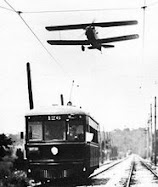Neil Reid, director of the University of Toledo Urban Affairs Center, warned transit officials to consider the American comfort level with buses.

Along for the ride? Wisdom from Ohio...
While bus ridership in both Toledo and Cleveland has grown in recent months, diesel costs have ballooned. And those fuel bills threaten the revenue and viability of busing systems across the country. “Many systems around the state, instead of adding service when demand is at an all-time high, are probably going to be cutting service,” Mr. Calabrese said.“My diesel bill went from $5 million in 2003, to $12 million last year, to $21 million this year, and it should be about $24 million next year.”In Toledo, TARTA will cut its bus service by 7 percent on Aug. 24, a decision that has caused outcries from local riders.Aside from rising fuel prices affecting expansion possibilities, Neil Reid, director of the University of Toledo Urban Affairs Center, warned transit officials to consider the American comfort level with buses.“Most people in Toledo, people say under 50, probably have never ridden a bus before or only on sporadic occasion,” he said. “People probably just don’t consider that an option.”The issues may cut deeper than simple unfamiliarity.Busing systems in many cities have been painted as ferries for the poor. Alan Plattus, director of the Yale Urban Design Center in New Haven, Conn., said dismantling a classist attitude — as has been done in many European countries — may be as important to the success of buses in America as the routes they follow.“The bus system has gotten to be a class system,” he said. “Middle class people who might use the bus instead of taking a car trip don’t do it.”For many urban planners, busing systems also have become the figurative poor man’s light rail, a shot below the mark for cities focusing on asphalt instead of track and relying on tenuous data promising real estate development around buses.John Norquist, president of the Congress for the New Urbanism in Chicago, agreed developers are more likely to be attracted to areas along rail stations or lines where the city has signaled its intention to make large, nearly indelible investments.“Light rail is good because it’s permanent,” he said. “People say with buses they’re good because they’re flexible, but they could disappear at any moment.”Light rail — the term applied to streetcar systems such as trolleys — is nothing new.The Richmond Union Passenger Railway came online as the first large electric street railway system in 1888, displacing horse drawn buggies. Many cities, including Toledo, decommissioned their streetcar systems in the 1950s as the country began its migration to the suburbs and the automobile industry flourished.Finding the right pathJames Seney, former executive director of the Ohio Rail Development Commission, said old streetcar lines in Toledo fit the layout of the community and may be a guide for rail revampment.“What makes urban rail work is when you create transit routes that have clusters of neighborhoods on them,” said Mr. Seney, the former mayor of Sylvania. “You should design [routes] based on your existing neighborhoods and tie that into the growth of downtown businesses, rather than trying to capture a larger area.”Though Mr. Seney said new tracks would be needed if Toledo decided to move forward with a rail plan, he admitted “the old guys logistically were correct.” The push toward rail is being seen in other U.S. cities.About 100 years after its invention, light rail experienced a heavy resurgence. Most of the United States’ busiest light rail systems today were built or intensely renovated in the last two decades, including lines in Los Angeles; Portland, Ore.; St. Louis; Denver, and Dallas. Even smaller cities such as Little Rock, Tacoma, and Galveston, Texas, have invested in light rail systems since the turn of the century.The Massachusetts Bay Transportation Authority in Boston shuttles over a quarter million people per day on its green and red lines, making it by far the largest light-rail operation in the country.


























No comments:
Post a Comment